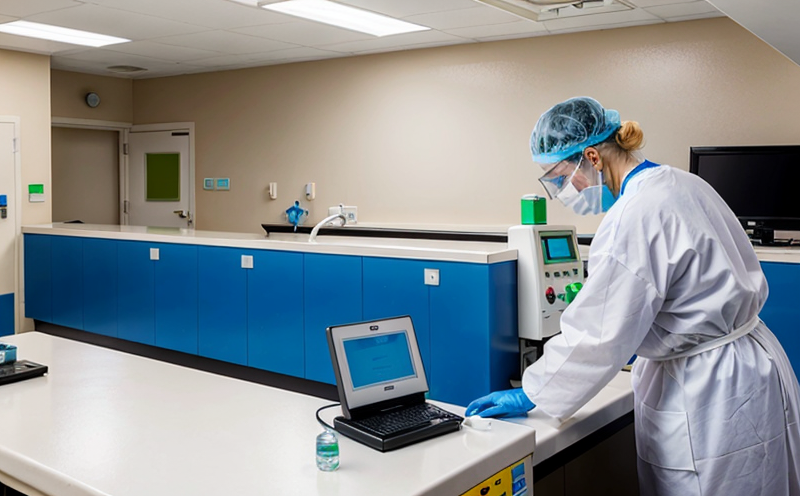Sterility Testing of Surgical Instruments Post-Sterilization
When it comes to surgical instruments, sterility is paramount. Post-sterilization testing ensures that these critical tools meet the highest standards for safety and efficacy in healthcare settings. Sterility testing involves a series of procedures designed to confirm the absence of viable microorganisms on or within the instrument, ensuring they are free from contamination.
The process typically begins with the collection of samples from various parts of the surgical instruments, including handles, blades, and hinges. The collected specimens are then inoculated into suitable culture media that support bacterial growth. Incubation periods vary based on the type of microorganism being targeted; for instance, bacteria may require 48 hours to grow visibly while spores could take up to seven days.
During this time, laboratory personnel closely monitor the samples for signs of microbial activity. If any colonies appear, they must be identified and quantified using techniques such as colony-forming unit (CFU) counting. This step is crucial in determining whether the instrument has been effectively sterilized according to industry standards.
Post-sterility testing also includes sterility assurance level (SAL), which specifies a probability that a single viable microbial pathogen will remain on an item after processing. Typically, SAL targets are set at 10-6, meaning there should be less than one chance in a million that any given instrument contains live microorganisms.
To further enhance reliability, we employ advanced technologies like real-time PCR (polymerase chain reaction) for detecting even trace amounts of DNA from pathogens. This method allows us to detect very low levels of contamination early on, allowing adjustments to the sterilization process if necessary.
Our team utilizes ISO 17604:2019 as our guiding document when conducting sterility testing, which sets out detailed procedures for biological indicators and sterilization validation. By adhering strictly to these guidelines, we ensure consistent results that are both reproducible and reliable across different batches of surgical instruments.
Additionally, our facilities are equipped with state-of-the-art laboratories staffed by highly trained professionals who understand the nuances involved in performing accurate sterility tests. They work diligently to provide comprehensive reports detailing each stage of testing, including any deviations from expected outcomes. Such transparency allows healthcare organizations and manufacturers alike to make informed decisions regarding quality control measures.
In summary, our sterility testing service plays an integral role in maintaining the integrity of surgical instruments throughout their lifecycle. By rigorously following established protocols and leveraging cutting-edge technology, we help ensure that these tools remain safe and effective for use in medical procedures.
Applied Standards
The sterility testing process adheres to several internationally recognized standards aimed at ensuring accuracy and reliability. One of the key documents used is ISO 17604:2019, which provides comprehensive guidance on the use of biological indicators in sterilization validation processes.
ASTM E2385-15 also serves as a valuable reference for assessing the sterility status of medical devices. This standard covers methods for determining whether items have been rendered sterile by heat treatment or other means. Another relevant document is EN ISO 11737, which specifies requirements for steam sterilizers used in healthcare environments.
These standards collectively provide a framework within which our testing procedures are conducted, ensuring compliance with regulatory expectations and industry best practices. Compliance ensures that the results obtained from our tests can be trusted by all parties involved – from manufacturers to regulatory bodies.
Scope and Methodology
The scope of our sterility testing service encompasses a wide range of surgical instruments, including but not limited to scalpels, forceps, scissors, retractors, and needles. We also extend our expertise to non-invasive devices like catheters and endoscopes when they require similar levels of hygiene.
Our methodology involves several key steps:
- Sample collection from various surfaces of the instrument
- Inoculation into appropriate culture media
- Culture incubation to allow potential microorganisms to grow
- Colony-forming unit (CFU) counting and identification
- Determination of sterility assurance level (SAL)
Throughout this process, our laboratory personnel meticulously document every aspect of the testing procedure. This documentation forms part of the final report which includes recommendations for improvement if any issues were identified during the test.
Industry Applications
In healthcare settings, maintaining sterile conditions is crucial to preventing infections and ensuring patient safety. Our sterility testing service supports hospitals and clinics in achieving this goal by verifying that all surgical instruments used during operations meet stringent sterilization requirements.
For medical device manufacturers, our service provides assurance that their products comply with regulatory standards before they reach the market. This helps build trust among end users who rely on these devices for treatment purposes.
Moreover, our expertise extends to research and development teams looking to optimize sterilization processes or develop new technologies aimed at improving hygiene levels in healthcare facilities.





